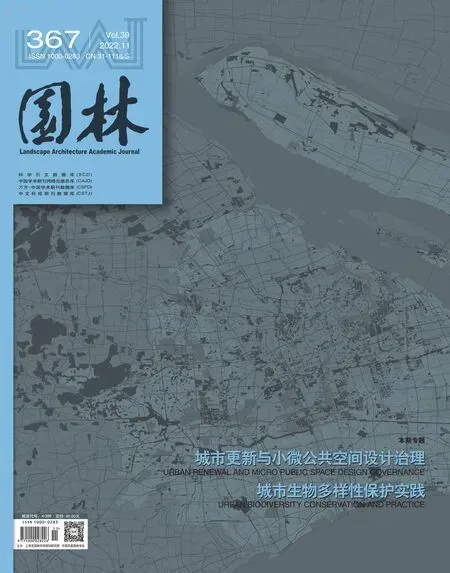为城市市井生活设计小微公共空间
2022年9月22日,上海市十五届人大常委会第四十四次会议修订通过了《上海市市容环境卫生管理条例》。新版《条例》注重城市精细化管理要求,明确了在适当位置满足城市烟火气的需要,象征着“路边摊”的有条件回归,体现了“人民城市为人民”的理念。其实,欧美城市更新历程中,都经历了从大规模清除贫民窟运动转向社区环境的综合整治、社区经济复兴以及居民参与下的社区邻里自建;都从大规模以开发为主导的造新城、推倒重建转向小规模、分阶段,由社区自组织的谨慎渐进式“微改造”。中国城市在过去的30多年,很大程度上沿袭了西方国家功能导向的现代主义规划模式,城市空间巨量增长。而在进入存量发展背景下,北京、上海等超大城市已从大规模的快速城市扩张转向小规模渐进式的城市更新发展阶段,高密度建成区“小微公共空间”的稀缺性和重要性日益凸显。
与密集而冰冷的高楼大厦所营造的城市空间不同,城市一隅小微公共空间存有烟火气与文化味,是现代化城市气度和温度的重要体现。正如著名城市规划师、建筑师伊利尔·沙里宁所说:“让我看看你的城市,我就能说出这个城市居民在文化上追求的是什么。”城市小微公共空间的设计治理,往往总是从问题出发,自下而上,具有小中见大的特点,小微尺度的空间重构、公众参与和社会激活成为将空间关怀落实到社区生活需求、社会关系等社会治理层面的重要途径。但在实际生活中,小微公共空间常缺乏规划设计、无人管理或亟需维护,处于被闲置或消极使用的状态,具有非正式性和临时性;基于小微公共空间的设计介入是城市管理者、设计师以及居民之间沟通的重要手段。这与传统语境下的“设计”不同,其具有低成本、低门槛、广参与、多合作、重过程的特征,可以形成分步骤的可持续微更新。
本期专题1“城市更新与小微公共空间设计治理”,研讨了城市小微公共空间的设计介入,从社区辐射到街区、从口袋公园过渡至社区生活圈,聚微成网,延续城市生长脉络。通过试点工程,调动公众参与,触发基层治理,从而带动无穷的社会力量,形成“1+N+∞”的工作路径;搭建多方参与的治理平台和模式,进一步挖掘微空间能人和自组织,开展可持续的空间营造活动,推进参与式的设计与共建;利用小微公共空间促进社区生活圈的治理,从单一的空间设计到社会关系的组织,从提升空间美学到空间及社会内容的策划,从被动的技术服务到主动的制度及生活方式构建,以实施全生命周期的规划治理、全社会协调的行动机制。另外,本期专题2“城市生物多样性保护实践”,探讨了从社区花园到城市湿地公园再到国外的城市生物多样性多元性保护,基于城市不同的绿地类型以及生物在自然界中的生存环境,形成不同的立地条件,打造以本地动植物为主的多层次生物结构,强化多样性赋存生境塑造。
风景园林设计师介入“城市—社区—微空间”的空间研究,顺应了城市建设管理的阶段性要求,将进一步引导城市居民的新生活。“城市是一本打开的书”,本期研讨作为铺垫,是回顾总结,也是思考探索,期待未来有更多的研究不断探寻“它的抱负”。
主编
2022年10月20日
Designing Micro Public Space for Urban Daily Life
On September 22, 2022, the 44th Meeting of the Standing Committee of the 15th Shanghai Municipal People’s Congress revised and passed The Regulations of Shanghai Municipality on the Administration of City Appearance and Environmental Sanitation.The new version of The Regulations pays attention to the requirements of urban refined management, reflecting the concept of “people’s city for people”.Meeting the needs of urban pyrotechnic gas in an appropriate location symbolizes the conditional return of “roadside stalls”.Actually, in the process of urban renewal in Europe and the United States, cities have experienced a shift from large-scale slum clearance to comprehensive improvement of community environment, community economic revival and community neighborhood self construction with the participation of residents; They have changed from large-scale development oriented new city building, demolition and reconstruction to small-scale, phased and self-organized“micro transformation”.In the past 30 years, Chinese cities have largely followed the function oriented modernist planning model of western countries, and urban space has grown tremendously.Under the background of stock development, mega cities such as Beijing and Shanghai have shifted from large-scale rapid urban expansion to small-scale progressive urban renewal and development.The scarcity and importance of “micro public space” in high-density built-up areas are increasingly prominent.
Different from the urban space with dense and cold high-rise buildings, the micro public space in one corner of the city has a smoky atmosphere and cultural flavor,which is an important embodiment of the modern urban demeanor and temperature.As the famous urban planner and architect Eliel Saarinen said, “Let me look at your city, and I can tell what the city residents are pursuing in culture.” The design and governance of urban micro public spaces are always based on the problem, from bottom to top, with the characteristics of seeing the big from the small.The reconstruction,public participation and social activation of micro scale space have become important ways to implement space care to community life needs, social relations and other social governance levels.However, micro public spaces are always being ignored in daily life.The design intervention based on micro public space is an important means of communication between urban managers, designers and residents.This is different from the “design” in the traditional context.It has the characteristics of low cost, low threshold, wide participation, multi cooperation and heavy process, and can form a sustainable micro renewal step by step.
Topic 1 of this issue, “Urban Renewal and Micro Public Space Design Governance”, discusses the design intervention of urban micro public space, from the community radiation to the block, from the pocket park to the community life circle,the micro network continues the urban growth.Through the pilot project, a “1+N+∞”working path is formed by mobilizing public participation and triggering grassroots governance; By building a governance platform and mode of multi participation,micro space talents and self-organization is further explored, so as to promote participatory design and co-construction, and to implement the whole life cycle planning governance and the whole society coordinated action mechanism.In addition, Topic 2 “Urban Biodiversity Conservation and Practice” of this issue discusses the diversity protection of urban biodiversity from community gardens to foreign countries.Based on different types of urban green spaces and living environments of organisms in the nature, different site conditions are formed, multi-level biological structures dominated by local animals and plants are created, and the creation of diverse habitats is strengthened.
Landscape architects involve in the space research of “city-community-micro space”, which conforms to the phased requirements of urban construction management and will further guide the new life of urban residents.“The city is an open book”.The discussion of this issue is a foreshadowing, a review and summary as well as a reflection and exploration.It is expected that more research will continue to explore “its ambition” in the future.
Editor-in-Chief
October 20th, 2022

